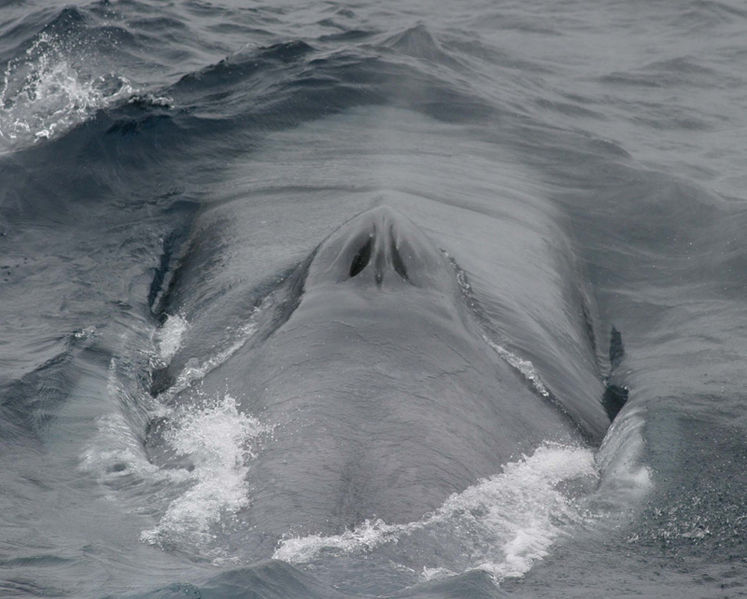MultipleOrganisms.Net 
Anatomical Adaptations
A Mammal? In the ocean?
Blue Whale Photos by Oceanlight.com
Blubber
Being a warm-blooded mammal presents one of the biggest challenges for Balaenoptera musculus. Heat loss in water is 27 times greater than the same temperature on land, thus blue whales must adapt to the cool ocean temperatures to avoid excessive heat loss and to maintain metabolic activity. Whale blubber acts as a form of protection and as a thermal insulator. The blubber actively controls the output of heat to maintain a steady internal body temperature despite the temperature of the environment. Unlike terrestrial animals, blue whales have no hair for insulation and no skin glands for evaporation. Instead, they utilize thickness and blood flow to stay warm. Blubber takes up about 27% of a whale's body mass, and it is composed of the epidermis, dermis, and hypodermal tissue. The epidermis, with an average thickness around 3.25 mm, comprises the outermost layer of blubber. Extensions of the dermis penetrate the epidermis, creating dermal ridges. At the ends of these dermal ridges are dermal papillae. Most mammals have papillae at the base of the epidermis. Human papillae (50 papillae/m²) are twice as dense as those found in the blue whale. The dermis consists of connective tissue fibers that run perpendicular to the epidermis. The thickness is about .34 mm. The dermis is densest near the epidermis. Density decreases closer to the hypodermal tissue because of the presence of fat cells. The hypodermal tissue is mostly made up of fat cells and accounts the most for the thickness of the blubber. It has characteristics similar to the fat beneath the skin of a pig and the fatty tissue under the skin of humans.
Heart and Circulation
Blue whales have a four-chambered heart with a closed circulatory system. This characteristic helps distinguish whales as mammals instead of fish, which have 2-chambered hearts. A human can crawl through the arteries of a blue whale. Weighing 2,000 pounds, a blue whale's heart beats so loud that it can be heard from 2 miles away. Beating once every ten seconds, it pumps 20,000 pounds of blood throughout the body. At the flippers and dorsal fin the veins wrap around the arteries to utilize the heat, since the whale must constantly maintain body temperature. Arterioles run through the hypodermis to the base of the epidermis, branching off every so often. Capillaries are located in the papillae. The extensions of dermal ridges into the epidermis allows for more blood flow near the surface and the blubber.
Blowhole
Courtesy of the NOAA
Without gills, whales cannot breath underwater. Instead, a blue whale uses its blowhole to inhale and exhale oxygen. The blowhole is positioned on top of the head to effectively surface for air. When the blue whale surfaces, it inhales enough air to fill a minivan, and when it exhales it sprays water as high as 30 feet into the air! The blowhole is large enough for a young child to crawl through.
Lungs
Because they live underwater, blue whales need highly efficient lungs to survive. Their lungs exchange 80-90% of oxygen, as opposed to humans who only exchange 10-15%. The trachea extends all the way to the center of the lungs to help adapt to its diving habits.
Sleep
Blue whales can never fall asleep completely because they would drown otherwise. Blue whales are conscious breathers and need to constantly stay awake. To solve this issue, whales only rest one half of their brain at a time while the other half stays awake.
Fins and Tail Flukes
Photo courtesy of Mike Baird
Balaenoptera musculus have dorsal fins and a tail refered to as a fluke. As opposed to fish, which swing their tails from side to side, whales move their flukes up and down. This is due to the fact that blue whale spines can bend vertically, but not much so horizontally. Thus, the tail is very broad to propel the whale through the ocean depths. The dorsal fin stands 30 cm at its highest and has a curve to improve the whale's swimming speed.
Eyes
Blue whales have complex eyes. The average size is that of a grapefruit. Unlike their terrestrial counterparts, blue whales lack tear glands and eyelashes.
Ears
Because they live in the dark depths of the ocean, blue whales have adapted excellent hearing to navigate instead of improving eyesight. Enhanced hearing also enables long distance communication between whales. The ears are internal, not external, to increase swimming speed. Instead, they have air sinuses and bones to detect sound. Blue whales make sounds louder than jet engines (up to 190 decibels), yet humans cannot hear them because of their low frequencies. Scientists can estimate the age of a whale by counting the layers of wax in its ears. The blue whale lifespan is estimated to be 80-90 years, although it is believed that they can reach an age as high as 110.
Spine
Photo courtesy of Jeffrey
Like humans, the blue whale's spine is flexible vertically but not horizontally, so it must resort to rolling on its side to make sharp turns.
For details on feeding adaptations, see NUTRITION.



